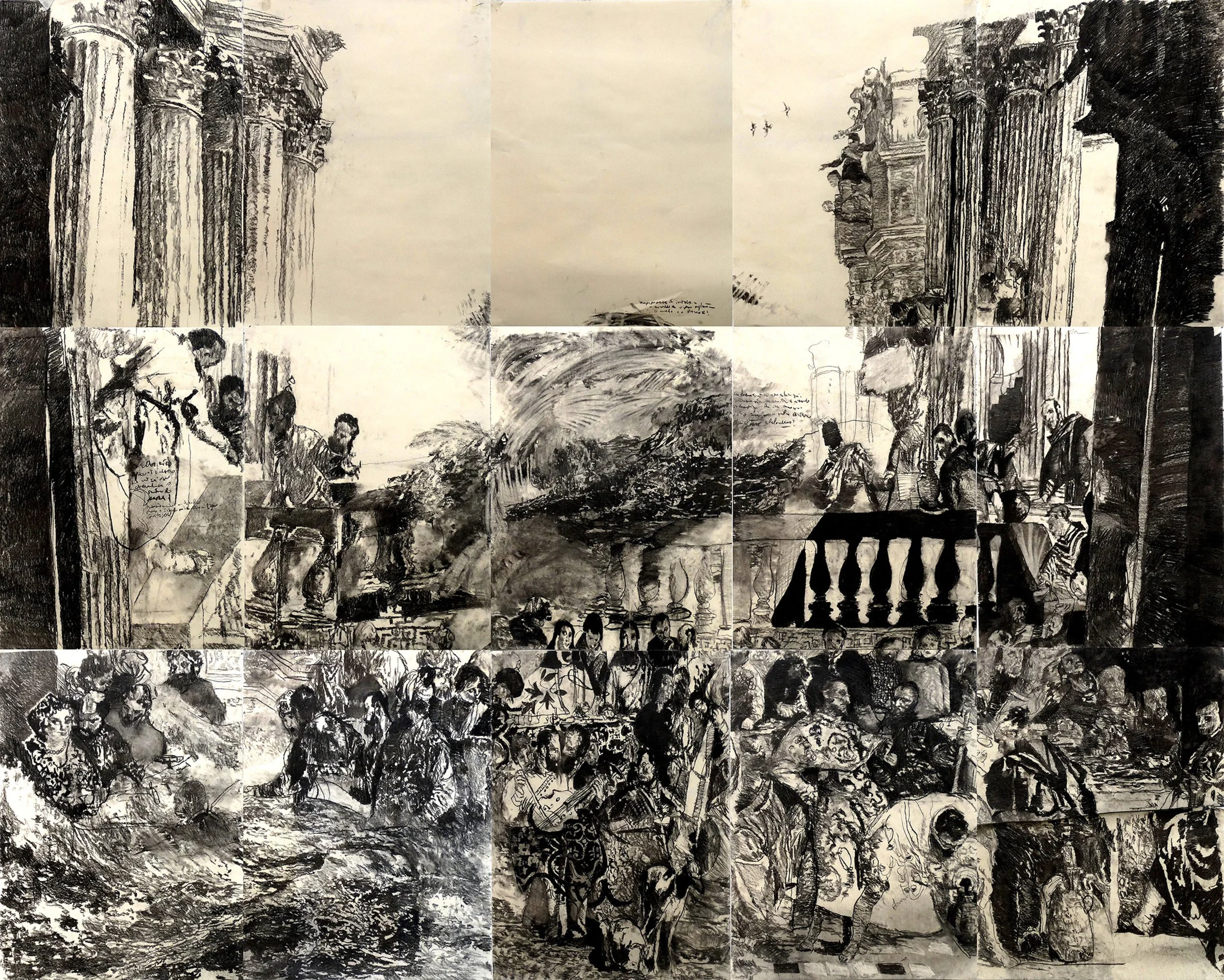The Great Arrival or The World Creation, charcoal on paper, 2018 | 240x300cm l © k37 studio, bethanien Berlin (Enter Foundation Collection)
After Cana
This charcoal drawing by Jorge Da Cruz revisits Paolo Veronese’s The Wedding at Cana, reimagining the iconic banquet through a darker, more fractured lens. In place of celebration, the scene unfolds as a quiet catastrophe. Water has entered the space—flooding the floor, rising among the guests. Some figures seem aware of the danger, others remain still, detached, or unaware. The atmosphere is suspended between excess and erasure.
The composition retains the structural echoes of Veronese’s original: the abundance of food and drink, the architectural framing, the presence of many figures drawn from different walks of life. But in Da Cruz’s reinterpretation, the moment is no longer festive—it is precarious. The birds in the distance, small yet present, chart erratic paths across the sky, hinting at a disturbance beyond the visible. Their motion becomes a subtle signal of what’s to come.
Charcoal lends the work its atmosphere: dense, textured, and full of contrast. Light flickers across surfaces, but the weight of the medium pulls the image downward. The drawing invites attention not to spectacle, but to fragility—to what happens when something trusted begins to dissolve.
After Cana does not erase the original painting’s spirit, but disturbs it. The feast remains, but it is altered. In doing so, the work reflects on the vulnerability that underlies celebration, and the tension between surface and undercurrent. It raises quiet questions: What do we ignore while we celebrate? How do we respond to what we cannot control? Where does beauty end, and forewarning begin?
The Wedding Feast at Cana
Paolo Veronese, 1563
Oil on canvas, 677 × 994 cm
Louvre Museum, Paris
The Wedding Feast at Cana is a monumental work by Paolo Veronese, completed in 1563. Measuring nearly seven by ten meters, the painting was originally commissioned for the refectory of the Benedictine monastery of San Giorgio Maggiore in Venice. It now resides in the Louvre Museum, where it stands as one of the most expansive and complex compositions of the Italian Renaissance.
The scene illustrates the biblical account of the wedding at Cana (John 2:1–11), where Christ performs his first miracle by turning water into wine. Veronese stages the event within a vast architectural setting—an open banquet hall framed by classical columns and rising structures. The table is crowded with figures: guests, servants, musicians, and animals, each rendered with careful attention to posture, gesture, and gaze.
Rich in visual detail, the work merges sacred narrative with the grandeur of Venetian life. The attire is contemporary to Veronese’s time—layered fabrics, intricate patterns, and finely rendered jewelry—imbuing the scene with a sense of lived opulence. The palette is luminous: deep reds, greens, blues, and golds cohere in a rhythm of light and surface that animates the entire composition.
More than an illustration, The Wedding Feast at Cana is an orchestration of movement and stillness, intimacy and spectacle. It exemplifies Veronese’s mastery of scale, atmosphere, and spatial complexity—qualities that continue to resonate far beyond its historical context.
Great Arrival#2 l 320x180cm l © k37 studio, bethanienArtCenter Berlin 2020
Great Arrival l 240x180cm l © k37 studio, bethanienArtCenter Berlin 2020



